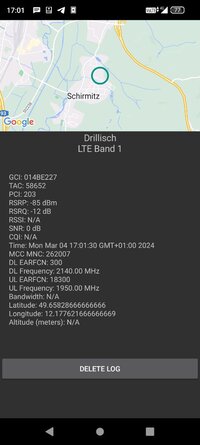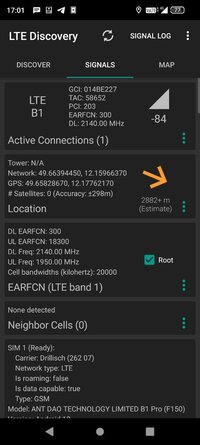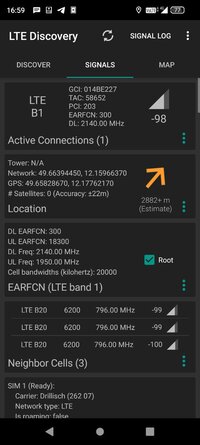Here comes the LTE thread.
The aim is at first to write down everything that I know and to give others a proper place to collect information.
Thanks to @johnicboom we finally can collect some data on Letux OS and compare it with the Pyra OS output, so it finally makes sense to start this discussion here.
One of the first things I investigated once I picked up my Pyra again was LTE, so I'll start with my observations
Vanilla Pyra behavior
To get over this quick, let's do some bullet points:
Testing with external antenna
Apparently the Pyra has a connector for an external antenna. I am not sure if that is true or if it is just a debug port. I got different inputs on that, however I believe that it's an external antenna port.
At least an external antenna does fit and as such I tested it all with third party antennas.
2 antennas were tested. I chose them because they were the only ones that I could easily source via Amazon.
Those two were tested:
Both antennas gave me some improvement. I was able to connect and even browse the web with them. However,
I got the best results with antenna 1 sticking to the housing.
I recall for sure that I used that setup somewhere outside to browse the Internet with the Pyra. However the experience was not reliable enough that I wanted to keep the antenna.
Investigating frequencies
I raised the issue to @hns via E-mail. His response was like that:
We then had some conversation regarding frequencies.
I am using O2 and those are the frequencies they use:
(source: https://de.wikipedia.org/wiki/Liste_von_LTE-Netzwerken)
In comparison, here is the data sheet of the EU-modem: https://www.gs-m2m.de/fileadmin/Bilder/GSM_Module/Module/PHS8/gemalto_datasheet_PHS8_web.pdf
We use PHS8-E.
The more recent one would be PLS83W: https://www.gs-m2m.de/fileadmin/Bil.../pls83-W/Thales_Cinterion_PLS83_Datasheet.pdf
It supports more bands. Directly quoting hns here:
So apparently the PHS8-E does not support 2600 and 700MHz bands and hns raised that this might cause the issue if those were the most prevalent bands in my area.
I kindly disagree and I can support my stance quite well.
First, I have an older phone here. It is from 2015 and connects perfectly well. The phone supports 800/850, 900, 1700, 1900, 2100 MHz, so no 700 and 2600 MHz (source: https://forums.crackberry.com/black...ry-priv-models-supported-frequencies-1043968/)
Second, my current phone that already has a 5G modem and most likely supports all recent frequencies also connects to those older bands. I was able to investigate that because the phone is rooted and I was able to run an app that displays the connection strength and the frequencies I connect to.
Here are some screenshots:



The conclusion I draw is this:
Of course I can not ruse out that the more recent modem would make a difference, however I can not see why and I would not at all rely on a new modem to fix the LTE issue.
Interference
In Austria at the Level Up I talked to a visitor who told me that he works in the LTE business.
His estimate was that there is some interference causes, especially because the modem and antenna are so close to the charging electronics and the battery. He advised me to test LTE without a battery attached.
I did exactly that, booted the Pyra and removed the battery.
That however made zero difference and I got better reception with the battery in and an external antenna.
LeTux
To investigate whether the issue is hardware related or if we use an improper config, I wanted to test LTE on LeTux OS.
Unfortunately I was not able to make a boot SD and got stuck.
Finally thanks to the help of @johnicboom , we were finally able to investigate LTE under LeTux.
It seems like it made no real difference for him and LeTux leads to equally bad results.
His first tests can be seen here: https://pyra-handheld.com/boards/threads/letux-os.100034/post-1719870
the conclusion of this is that there is no software issue or that some config is wrong in both OS. Maybe a more recent versions of "something" causes the issue.
Other guesses
Wat follows is a collection of guesses that I remember, which have been raised on Discord or anywhere else.
And that is basically all I know in regards to LTE. May the discussion begin.
The aim is at first to write down everything that I know and to give others a proper place to collect information.
Thanks to @johnicboom we finally can collect some data on Letux OS and compare it with the Pyra OS output, so it finally makes sense to start this discussion here.
One of the first things I investigated once I picked up my Pyra again was LTE, so I'll start with my observations
Vanilla Pyra behavior
To get over this quick, let's do some bullet points:
- The connection is generally bad
- In my house I do not get any connection at all
- In the garden, a connection can be established but it it nit stable at all
- If a connection can be established, it is in general very slow
- Others have reported that they can get a good if an LET station is very close and in direct sight range
Testing with external antenna
Apparently the Pyra has a connector for an external antenna. I am not sure if that is true or if it is just a debug port. I got different inputs on that, however I believe that it's an external antenna port.
At least an external antenna does fit and as such I tested it all with third party antennas.
2 antennas were tested. I chose them because they were the only ones that I could easily source via Amazon.
Those two were tested:
Code:
1: https://www.amazon.de/-/en/dp/B081JNMB5J
2: https://www.amazon.de/-/en/dp/B010GO59UABoth antennas gave me some improvement. I was able to connect and even browse the web with them. However,
- the connection in my garden happened almost instantly after booting
- connecting was not reliable, so even at the same spot, I could not always connect properly or lost connection from time to time
- connection chances still varied heavily where I stood in my garden
- no in house connection still
- First antenna
- Inside the housing, sticking on the SD cards, no SD card was inserted
- Outside the housing, the connection wire sticking out of the SD card slot, sticking at the bottom of the battery lid, no SD card was inserted
- Same as above but the antenna was dangling loosely
- Second antenna
- Outside the housing, dangling loosely (the antenna is inside a PCB and does not fit inside the housing
I got the best results with antenna 1 sticking to the housing.
I recall for sure that I used that setup somewhere outside to browse the Internet with the Pyra. However the experience was not reliable enough that I wanted to keep the antenna.
Investigating frequencies
I raised the issue to @hns via E-mail. His response was like that:
- This makes it seem like the modem is not properly compatible with the frequencies available
- It might be that some part (for example MMC-interface) causes disturbances
We then had some conversation regarding frequencies.
I am using O2 and those are the frequencies they use:
Code:
Deutschland O2/Telefonica 20 (800 MHz) Juli 2011
Deutschland O2/Telefonica 3 (1800 MHz) 2016 neue Frequenzlizenzen aus der Auktion 2015
Deutschland O2/Telefonica 7 (2600 MHz) 2013
Deutschland O2/Telefonica 1 (2100 MHz) Sep. 2018
Deutschland O2/Telefonica 28 (700 MHz) Apr. 2019 Telefónica will LTE 700 künftig punktuell dort einsetzen, wo eine bestehende Basisstation auf 800 MHz überlastet ist.[13] LTE 700 wird besonders im ländlichen Raum, z. B. in Niederbayern, aktiv genutzt.
Deutschland O2/Telefonica 8 (900 MHz) ab 2022 vereinzelt bereits dauerhaft aktiv, z. B. am Königssee (Oberbayern) oder bei Hausen/NiederbayernIn comparison, here is the data sheet of the EU-modem: https://www.gs-m2m.de/fileadmin/Bilder/GSM_Module/Module/PHS8/gemalto_datasheet_PHS8_web.pdf
We use PHS8-E.
The more recent one would be PLS83W: https://www.gs-m2m.de/fileadmin/Bil.../pls83-W/Thales_Cinterion_PLS83_Datasheet.pdf
It supports more bands. Directly quoting hns here:
FDD-LTE: bands 1, 2, 3, 4, 5, 7, 8, 12, 13, 18, 19, 20, 26, 28, 66
TD-LTE: bands 38, 40, 41
translated with https://en.wikipedia.org/wiki/LTE_frequency_bands (each MHz)
700
800
850
900
1700
1800
1900
2100
2300
2500
2600
So apparently the PHS8-E does not support 2600 and 700MHz bands and hns raised that this might cause the issue if those were the most prevalent bands in my area.
I kindly disagree and I can support my stance quite well.
First, I have an older phone here. It is from 2015 and connects perfectly well. The phone supports 800/850, 900, 1700, 1900, 2100 MHz, so no 700 and 2600 MHz (source: https://forums.crackberry.com/black...ry-priv-models-supported-frequencies-1043968/)
Second, my current phone that already has a 5G modem and most likely supports all recent frequencies also connects to those older bands. I was able to investigate that because the phone is rooted and I was able to run an app that displays the connection strength and the frequencies I connect to.
Here are some screenshots:



The conclusion I draw is this:
Of course I can not ruse out that the more recent modem would make a difference, however I can not see why and I would not at all rely on a new modem to fix the LTE issue.
Interference
In Austria at the Level Up I talked to a visitor who told me that he works in the LTE business.
His estimate was that there is some interference causes, especially because the modem and antenna are so close to the charging electronics and the battery. He advised me to test LTE without a battery attached.
I did exactly that, booted the Pyra and removed the battery.
That however made zero difference and I got better reception with the battery in and an external antenna.
LeTux
To investigate whether the issue is hardware related or if we use an improper config, I wanted to test LTE on LeTux OS.
Unfortunately I was not able to make a boot SD and got stuck.
Finally thanks to the help of @johnicboom , we were finally able to investigate LTE under LeTux.
It seems like it made no real difference for him and LeTux leads to equally bad results.
His first tests can be seen here: https://pyra-handheld.com/boards/threads/letux-os.100034/post-1719870
the conclusion of this is that there is no software issue or that some config is wrong in both OS. Maybe a more recent versions of "something" causes the issue.
Other guesses
Wat follows is a collection of guesses that I remember, which have been raised on Discord or anywhere else.
- We do not use the antenna at all
- The antenna is not properly mounted (pretty much ruled out already)
And that is basically all I know in regards to LTE. May the discussion begin.
Last edited:

